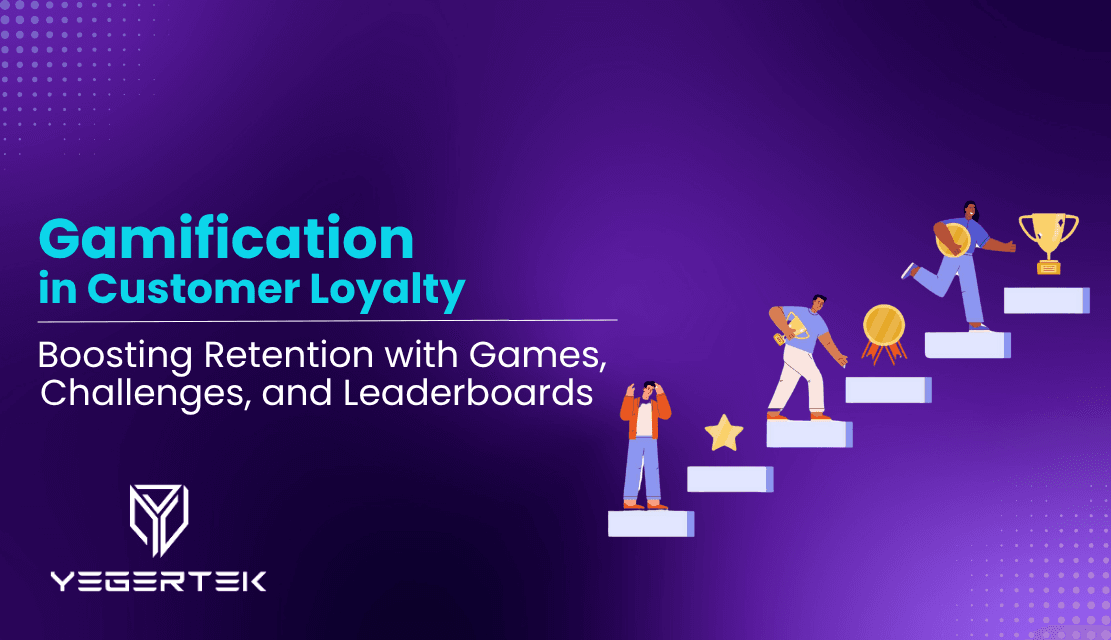
Games appeal to people of every age group – be it a short quiz, a ‘spin the wheel’ contest, or collecting badges to earn points, reward programs based on the concept of gamification not only cater to the spirit of competitiveness in customers, they give the customers a sense of accomplishment for completing the set challenges.
A key component in modern loyalty programs, the concept and applications of gamification are far and wide, with a rapidly increasing market base that is expected to reach USD 61 billion by 2030.
In this guide, we try to understand how businesses today are using games, challenges, and leaderboards to boost customer retention and how you can use gamification to boost customer loyalty. So let’s dive into it –
What is Gamification in Customer Loyalty?
The concept of gamification in customer loyalty is so broad that one is often left wondering what it actually means? Is it the tiered program? Or the friend referrals? In the context of loyalty programs, gamification is defined as using game-like elements and design features such as points, challenges, leaderboards, rewards, etc, to engage customers and enhance retention. It is a fun and effective way to encourage desired behaviour from your customers, motivating them to try new products or increase their interaction with the app.
The gamification strategies employed by a business could vary based on their business type or the trending gamification loyalty programs. Successful gamification strategies are more or less a blend of participation, consistent engagement, and healthy competition. Regardless of which gamification model you employ, whether it is a ‘wheel of fortune’ spin-and-win program or a daily quiz for rewards, if your loyalty program strikes the right balance, consumers engage with greater confidence.
Another important factor to consider with gamification in customer loyalty is privacy. While the latest privacy laws require businesses to provide customers with the option to accept or reject online cookies, it has been seen that the more transparent your gamification strategies are, the more chances are that the customers will engage with you. So to put it simply, gamification provides businesses with an opportunity to gather customer data in a fun and engaging way with the full consent of the consumer.
Why are Gamified Loyalty Programs So Effective?
When it comes to gamification in customer loyalty, it isn’t just about games, gamification works by appealing to the human psyche; leveraging rewards and meaningful interactions to build lasting relationships. As social creatures, humans have a tendency to engage and compete for positive reinforcement and appreciation, Gamification techniques appeal to this part of human psychology through game-like features that encourage a healthy competition for rewards, points, and other benefits.
Some of the reasons why gamification is an effective customer engagement strategy are:
- These customer loyalty programs leverage the power of rewards and motivation to keep them engaged and encourage them to buy again.
- They create a sense of progression and achievement, appealing to the competitiveness of consumers.
- By consistently rewarding the customers for their engagement, gamification loyalty programs turn shopping into a habit and foster repeat purchases.
- Gamification programs often share a leaderboard for challenges where users can see their progress and share the same on their social media channels. This way, loyalty programs tap into the social influence, promoting word of mouth,
- Since gamification in customer loyalty is a lot about making customer interaction enjoyable and emotionally engaging, it leads to stronger brand connections and a sense of belongingness.
The Impact of Gamified Loyalty Programs
To put it in simple terms, gamification makes interaction more fun, interactive, and rewarding for the customers, encouraging them to connect with the brand on a more personal level. This transformative impact helps in turning passive consumers into active participants, driving repeat purchases, deepening connections, and increasing customer loyalty. Here’s why gamification is crucial for customer retention:
- It increases customer engagement through rewards and challenges.
- It strengthens emotional connection through fun interactions.
- It encourages repeat purchases through tiered loyalty programs.
- It enhances brand loyalty by making customers feel recognized and valued.
- It also helps in targeting a younger section of consumers who are comfortable with smart technology.
Top Gamification Features in Customer Loyalty Programs
When it comes to gamified loyalty programs, the sky is the limit. Having said that, here are some of the most loved and trending gamification features for customer loyalty programs that you can use for your business:
1. Collectible Badges
A lot of businesses offer fun and creative badges for their customers to collect upon completing certain milestones or challenges. These badges can then be redeemed for either discounts, perks, or exclusive benefits. Challenges and badges not only give your customers a sense of accomplishment, but they also foster repeat purchases and increase brand loyalty.
2. Referral & Social Sharing
In today’s day and age, social media plays a key role in increasing brand awareness and reliability among customers. Rewarding your existing customers for referring friends or sharing their achievements on social media not only encourages word-of-mouth marketing, it also expands the customer base.
3. Mystery Rewards
A little bit of mystery goes a long way in customer loyalty programs. When you attach a mystery reward with a purchase, it creates an element of excitement, motivating the customers to make the purchase. Limited-time discounts do the same thing, triggering dopamine release and making the purchase a thrilling experience.
4. Leaderboards
Leveraging social comparison and competition to increase motivation is a classic gamification example used by businesses of all kinds. Customers are rewarded based on their spending, referrals, or the number of challenges completed while their progress is displayed on a leaderboard. This kind of customer loyalty program helps in increasing repeat purchases and spreading awareness about the brand.
5. Personalised Gamification
A lot of businesses such as e-commerce websites offer personalized rewards that adapt based on the customer’s preferences, behaviour, and purchase history. This not only makes engagement with the customers feel unique, it strengthens customer loyalty in the long-run.
The Best Way to Use Gamification in Customer Loyalty Programs
There are a lot of ways to effectively use gamification in customer loyalty programs. But first, there are some basic things that you need to get in line:
- Clearly outline your goals – Set what you want to achieve with your loyalty program and what rewards are you willing to give to your customers.
- Get a closer look at your customers – Understand their preferences, and behaviours, and get a clear picture of what kind of games are they most likely to engage with?
- Be open to feedback – Evaluate user feedback and work on optimizing your strategies for an effective loyalty program.
Once you have the above set of things in place, you can pick any gamification module of your choice and integrate it into your app or website, wherever your audience is most likely to engage. For example, if your target customers are millennials and Gen Z, they are more likely to interact with the in-app versions.
Final Thoughts
With more and more businesses embracing digital transformation, customer loyalty programs have transformed from mere reward systems to dynamics and interactive engagement methods that shape the overall experience of your customers. Gamification plays an important role in customer retention strategies, with the key lying in understanding your audience’s behaviour, their personal preferences, and optimizing their experience based on feedback. By leveraging elements like challenges, leaderboards, and interactive rewards, businesses get to easily boost engagement and encourage customers to make repeated purchases as loyal consumers of the brand. While to some, it may appear as a long-term strategy, when done right, it delivers sustained customer loyalty and business growth.



